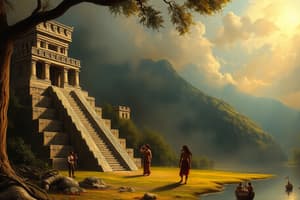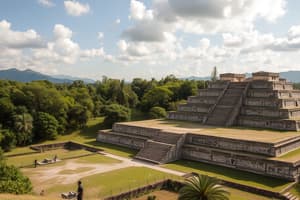Podcast
Questions and Answers
What was the primary reason for the Mexica settling on Lake Texcoco?
What was the primary reason for the Mexica settling on Lake Texcoco?
- To establish trade routes with other cities
- To find a fertile agricultural location
- To serve the Tepanecs in military campaigns (correct)
- To escape from enemy tribes
During which period did the establishment of the first complex societies in the Maya region occur?
During which period did the establishment of the first complex societies in the Maya region occur?
- The Archaic period
- The Classic period
- The Preclassic period (correct)
- The Postclassic period
What function was not typically combined under government offices in the new imperial order?
What function was not typically combined under government offices in the new imperial order?
- Military
- Cultural (correct)
- Political
- Religious
What role did the god Huitzilopochtli play in Mexica society?
What role did the god Huitzilopochtli play in Mexica society?
What was the importance of cenotes to the Maya civilization?
What was the importance of cenotes to the Maya civilization?
Which staple crop was primarily important to the Maya diet?
Which staple crop was primarily important to the Maya diet?
What was a calpolli?
What was a calpolli?
Which of the following was NOT a significant city-state in the Maya region?
Which of the following was NOT a significant city-state in the Maya region?
What significant event occurred in 1428 involving the Mexica?
What significant event occurred in 1428 involving the Mexica?
What architectural feature was common in Maya cities that emerged around 750 BC?
What architectural feature was common in Maya cities that emerged around 750 BC?
How could a commoner soldier achieve a higher social status in Mexica society?
How could a commoner soldier achieve a higher social status in Mexica society?
What did the Mexica adopt upon settling in the region of Lake Texcoco?
What did the Mexica adopt upon settling in the region of Lake Texcoco?
What form of agriculture did the Maya utilize for farming on frequently flooded land?
What form of agriculture did the Maya utilize for farming on frequently flooded land?
What did Tlatoani Itzcoatl do to consolidate the new political order?
What did Tlatoani Itzcoatl do to consolidate the new political order?
Under whose rule were the independent Maya city-states governed?
Under whose rule were the independent Maya city-states governed?
Which site is recognized as the largest and possibly housed 40,000 people in the Maya civilization?
Which site is recognized as the largest and possibly housed 40,000 people in the Maya civilization?
What was a significant factor contributing to the decline of the Maya civilization?
What was a significant factor contributing to the decline of the Maya civilization?
Which statement best describes the organization of the Maya civilization?
Which statement best describes the organization of the Maya civilization?
What happened to Maya books during the sixteenth century?
What happened to Maya books during the sixteenth century?
Which cultural activity is associated with the Maya civilization?
Which cultural activity is associated with the Maya civilization?
What event marked the end of the era of powerful Maya kings?
What event marked the end of the era of powerful Maya kings?
Who were the Nahuatl-speaking people that migrated to central Mexico?
Who were the Nahuatl-speaking people that migrated to central Mexico?
What was the Aztec Empire primarily built upon?
What was the Aztec Empire primarily built upon?
Who controlled much of the valley when the Mexica arrived?
Who controlled much of the valley when the Mexica arrived?
Flashcards
Calpolli
Calpolli
Clan-based communities organized by the Mexica.
Triple Alliance
Triple Alliance
A political coalition formed by the Mexica and other cities in the Valley of Mexico, defeating the Tepanecs.
Huitzilopochtli
Huitzilopochtli
The god of war, crucial to the Mexica's new history and the patron deity of the Aztec Empire.
Tenochtitlan
Tenochtitlan
Signup and view all the flashcards
Mexica
Mexica
Signup and view all the flashcards
Tepanecs
Tepanecs
Signup and view all the flashcards
Aztec Empire
Aztec Empire
Signup and view all the flashcards
Tlatoani
Tlatoani
Signup and view all the flashcards
Maya Civilization Location
Maya Civilization Location
Signup and view all the flashcards
Maya Diet Staples
Maya Diet Staples
Signup and view all the flashcards
Maya Archaic Period
Maya Archaic Period
Signup and view all the flashcards
Cenote Importance
Cenote Importance
Signup and view all the flashcards
Maya City-States
Maya City-States
Signup and view all the flashcards
Maya Milpa Farming
Maya Milpa Farming
Signup and view all the flashcards
Maya City Characteristics
Maya City Characteristics
Signup and view all the flashcards
Preclassic Maya Period
Preclassic Maya Period
Signup and view all the flashcards
Maya Civilization Organization
Maya Civilization Organization
Signup and view all the flashcards
Mayan Book Destruction
Mayan Book Destruction
Signup and view all the flashcards
Maya Civilization Decline
Maya Civilization Decline
Signup and view all the flashcards
Maya Farming Communities
Maya Farming Communities
Signup and view all the flashcards
Aztec Empire
Aztec Empire
Signup and view all the flashcards
Mexica Migration
Mexica Migration
Signup and view all the flashcards
Maya Vanishing Strategy
Maya Vanishing Strategy
Signup and view all the flashcards
Tepanec Alliance
Tepanec Alliance
Signup and view all the flashcards
Study Notes
The Americas
- The Maya inhabited the highlands of Guatemala and the Yucatan Peninsula in present-day Mexico and Belize.
The Maya
- The Archaic period (prior to 2000 BC) saw early developments in agriculture and villages.
- The Preclassic period (c. 2000 BC to 250 AD) marked the establishment of complex societies and the cultivation of staple crops like maize, beans, squash, and chili peppers.
- Maya cities developed around 750 BC and by 500 BC possessed monumental architecture, including large temples with elaborate stucco façades.
Yucatan Peninsula
- Limestone formations created deep natural wells called cenotes.
- Cenotes were critical sources of water, essential for farming, and became important religious and spiritual sites.
Maize and other food-stuffs
- Maize was the staple crop, often grown in small remote plots called milpas, along with beans, squash, chili peppers, root crops, and fruit trees.
- Farming on raised rectangular plots was common, built above seasonally flooded low-lying land bordering rivers.
Maya City-States
- The Maya region may have had as many as 14 million inhabitants.
- Sites like Uxmal, Uaxactun, Copan, Piedras Negras, Tikal, Palenque, and Chichen Itza emerged as independent city-states, each ruled by a hereditary king.
- These cities produced polychrome pottery, featured altars, engraved pillars, masonry temples, palaces for nobles, and pyramids.
- Tikal, the largest site, may have had 40,000 people, and served as a religious and ceremonial center. A hereditary nobility owned land, waged war, traded, exercised political power, and directed religious rituals.
The organization of the Maya
- Maya civilization was organized in City-States.
Examples of Mayan culture
- Maya ball game
Spanish influence on Maya history
- In the 16th century Spanish authorities viewed Maya books as demonic and ordered them to be destroyed. Only a handful survived.
- These surviving texts offered a glimpse into religious rituals, practices, and Maya astronomy.
The Decline of the Mayan Society
- Between the 8th and 10th centuries, the Maya abandoned their cultural and ceremonial centers.
- Archeologists attribute the decline to agricultural failures (drought, land exhaustion), overpopulation/disease, and constant wars.
- Widespread destruction, worsened by agricultural problems, saw royalty also suffer from the decline in civilization.
- The loss of powerful kings led subjects to turn against them.
Maya new farming communities
- The decline did not mean disappearance, Maya continued farming in communities.
- Construction of monumental architecture ceased around 900 CE. This was likely because of the era or rule by powerful kings who could mobilize the labor required to build it.
- Farming communities helped preserve culture and language.
The Vanishing strategy
- The Maya used a vanishing strategy against the Aztec army and later against Spanish conquistadores.
The Aztec Empire
- Between 1300 and 1345, a group of Nahuatl-speaking people (the Mexica) migrated to central Mexico, settling around Lake Texcoco, forming the Aztec Empire.
- The Aztec Empire was a vast and rapidly expanding empire centered around twin cities of Tenochtitlan and Tlatelolco.
- It was a network of alliances and tributary states, with the Mexica at its core.
The Mexica and the Tepanecs
- At the arrival of the Mexica, the Tepanec Alliance controlled much of the valley.
- The Mexica negotiated the right to settle on an island in Lake Texcoco in exchange for military service.
- They adopted the customs of the Tepanecs, organizing clan-based communities, and incorporated their deities.
Bernal Diaz del Castillo
- A description of the appearance of the Aztec cities and towns.
- They were astonished, seeming like an enchanted vision.
The Calpolli
- Clan-based communities organized by the Mexica.
The Defeat of the Tepanec
- In 1428, the Mexica formed a coalition with other cities in the Valley of Mexico, besieged the Tepanec capital, and defeated it.
- A new powerful alliance, the Triple Alliance, with the Mexica as the key partner, emerged.
- This alliance, and a new history drafted by Itzcoatl and his nephew, Tlacaelel, formed the foundation of the Aztec Empire, with Huitzilopochtli as the patron deity.
Huitzilopochtli
- The Hummingbird of the South, was a god unique to the Mexica who, according to their new official origin stories, instructed them to march south until they reached an island with the sign of an eagle eating a serpent.
The new Imperial Order
- Combined government, military, and political functions.
- Formalized the roles of noble and common classes.
- Secured five sacrificial victims = common soldier entering the lower nobility.
- Publicly display new status: feathers and flowers.
The End of the Aztec Empire
- Between 1519 and 1521, the Aztec Empire, under Moctezuma II, fell to Spanish conquistador Hernan Cortes.
- Cortes and men took Moctezuma prisoner.
- Tenochtitlan rose up to drive away Spanish, causing Moctezuma to be killed.
- Though the Spaniards were driven out, they introduced smallpox, which devastated the Aztec population in 1520.
Warriors and Sacrifices
- The need for sacrifice and glorification of warriors was central to the expansion of the Aztec Empire.
- The Aztecs viewed the warrior cult as a central observance and believed they were the chosen people.
- They believed that the apocalypse could be forestalled by the sacrifices of humans.
Studying That Suits You
Use AI to generate personalized quizzes and flashcards to suit your learning preferences.




